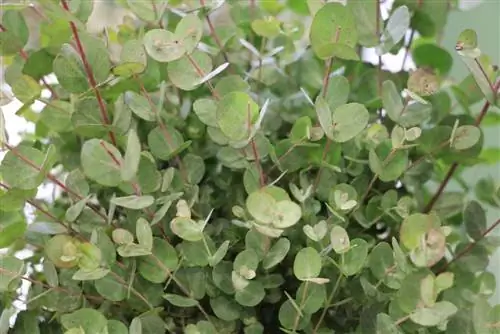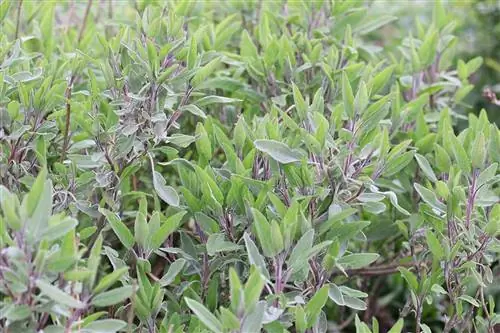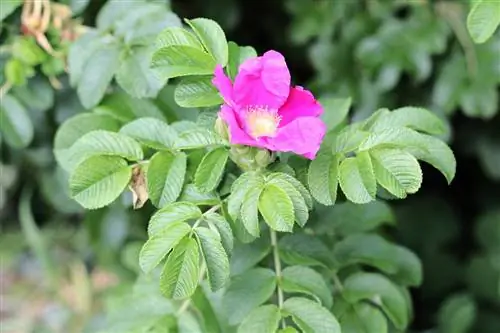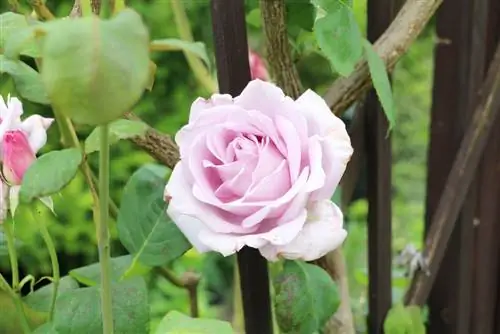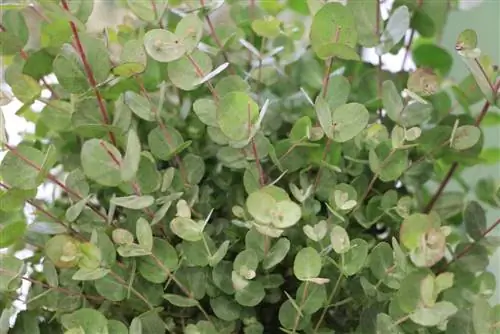- Author admin [email protected].
- Public 2023-12-17 03:39.
- Last modified 2025-01-24 12:45.
Two types of eucalyptus are known and loved by us from the Myrtaceae family, the Eucalyptus globulus and the Eucalyptus gunnii.
garden plant
The eucalyptus gunnii, which is considered to be reasonably frost hardy, is often found in home gardens. If the winter is extremely harsh, it should overwinter in a cool place, otherwise a sheltered place and light winter protection are sufficient. Young plants must be protected in any case; older plants can survive temperatures below zero undamaged. When planted outdoors, the eucalyptus needs a warm, sunny and wind-protected place on loose, lime-free substrate soil. You can also mix garden soil with grit, sand and bark humus as a substrate, but you should plan a drainage layer because waterlogging is not tolerated. Otherwise, the eucalyptus must be watered well, with the excess water draining away well.
- In winter you can let the eucalyptus dry out almost completely, thin it out and, best of all, place it in the winter garden in a bright location and temperatures between 5 and 10°C.
- Since the scent of eucalyptus repels flies and mosquitoes, it should be planted near the terrace or seating area in the garden.
- The eucalyptus should be propagated or repotted in spring when the eucalyptus ball is well rooted. Propagation can be done via seeds and is also easy to carry out.
- The plants grow relatively quickly, which has the advantage that you don't have to wait too long until you have a small tree.
In summer, the peculiar scent of these trees drives away mosquitoes, which is why they are often planted near the terrace or near the barbecue area. Not all eucalyptus species smell like eucalyptus. Some species, such as Eucalyptus citriodora, have a strong lemon scent. The well-known eucalyptus oil is obtained from Eucalyptus globulus.
- Eucalyptus leaves are relatively hard, which has the advantage for the plant that it can survive with little water.
- Waterlogging and moist soil are generally not tolerated well, so you should also ensure drainage.
- This can be achieved with good drainage. This should be ensured outdoors and in the pot so that the tree does not suffer any damage.
- The ideal location is full sun. Partial shade is also tolerated, but the eucalyptus tree feels most comfortable in the sun.
- The tree is fertilized every 14 days during the growing season with a normal complete fertilizer.
In the apartment
The blue gum tree with its almost stemless, heart-shaped, grey-blue leaves measuring 5 to 8 cm, grows up to 60 cm high in the wild and grows 90 to 130 cm per year indoors, for this reason it has to often be cut back. The Eucalyptus gunnii grows significantly less at only 40 cm per year. The leaves of this eucalyptus are also 5 to 8 cm large, but grow oppositely with a bluish color. Every eucalyptus needs a sunny, bright place. If this is not the case, the leaves lose their beautiful color and the shoots wither, although the temperature is of secondary importance because it thrives just as well in cool places as in warm places.
During main growth, the soil must always be well moistened, so even watering is recommended. Before watering the plant again, the surface of the substrate should be dry. If you want to give the plant a break in winter, place it in a cool place at around 13°C and limit watering considerably; you just have to ensure that the plant does not dry out completely. The best way to cultivate eucalyptus is with a substrate made of compost soil. The plant is most likely to be propagated by seeds embedded in a mixture of peat and sand, which is slightly moistened.
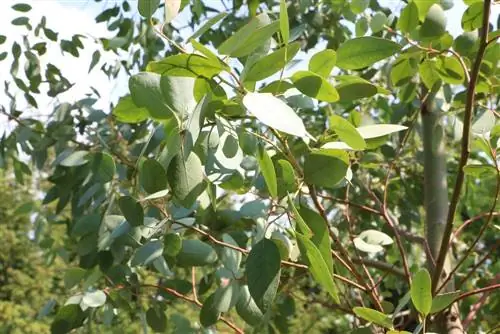
In the propagation box with a temperature of approx. 23°C, the first seedlings appear after just 3 to 4 weeks. If the first leaf shoots with leaves can be seen, they should be pricked out and placed in pots with compost soil. As the plant grows, it may need to be repotted twice a year. It is important to ensure that the roots are completely covered with fresh substrate. Fertilizer is used in liquid form, as pot plant fertilizer, about every 14 days from spring to autumn.
Pests
Pests can occur with eucalyptus in the home as well as in the garden, which in most cases are scale insects or mealybugs. However, you can take preventive measures here and spray the plants with leaf shine. The leaf shine, available from specialist retailers, is a combination of plant-compatible oils and ensures a bright leaf color and a lasting shine on the leaves, which prevents them from collecting dust for a long time. Water and limescale residues from water droplets, which cause the leaves to turn gray, are removed and, as a replacement, paraffin oil also has the same benefit. Spraying the leaves also reduces pest infestation if the leaves and stems are evenly coated with it. So it is a preventative measure for both outside and inside.
Aphid infestations often occur at the beginning of May, resulting in dark sooty mold fungi. Previous treatment with paraffin oil or leaf shine also helps here. However, if the plant's shoots are attacked by aphids or the so-called eucalyptus sucker, which rarely happens because of its essential oils, then it can be placed completely under cold water for 24 hours, with a soft soap solution to which spirit has been added, or with a neem tree preparation be treated. The plant survives each of these treatments, but the lice do not.
Garden tools for proper handling of eucalyptus
The eucalyptus does not require much care, but you should have a few things ready before buying:
- sufficiently large plant pots if the eucalyptus is kept indoors
- Propagation box for growing seedlings,
- Watering can,
- Planting shovel,
- Garden scissors,
- Substrate made from compost soil for indoor use,
- a mixture of sand, earth, grit and bark humus for outside,
- for the seeds a mixture of peat and sand,
- Drainage must be provided outdoors,
- In the apartment this is done by a plant pot with a hole,
- Spray bottle for the paraffin oil,
- alternatively leaf shine spray from specialist retailers,
- liquid fertilizer for potted plants
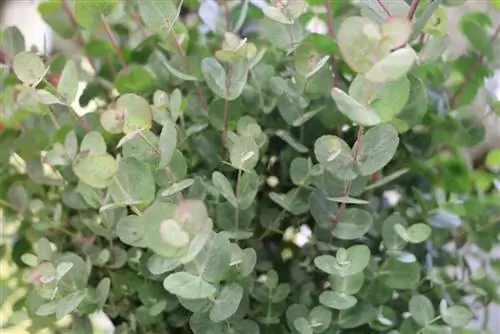
If hobby gardeners have the necessary accessories at hand, they can enjoy the eucalyptus plant for a long time, regardless of whether the plant is indoors or outdoors. With its diversity of species, the eucalyptus is a popular plant that can be kept both indoors in flower pots and outside in the garden bed. Due to its sprawling and rapid growth, it often needs to be cut back, but otherwise requires little care. The eucalyptus only needs to be watered regularly and fertilized every 14 days. It loves sunny, warm places and is rarely affected by pests.
Interesting facts
You've probably heard of it: Most types of eucalyptus trees grow in Australia. Here they are represented by around half of the total 500 species. In our latitudes and in the Mediterranean region, eucalypts are often cultivated as an ornamental plant. Unfortunately, most of the species available here are not frost hardy, so they must be protected from frost in winter. However, there is probably the best-known species in our country, the Eucalyptus gunnii, which is partially frost-hardy. In areas with very cold winters, it must be kept frost-free over the winter, but in milder regions, light winter protection outside is sufficient.

